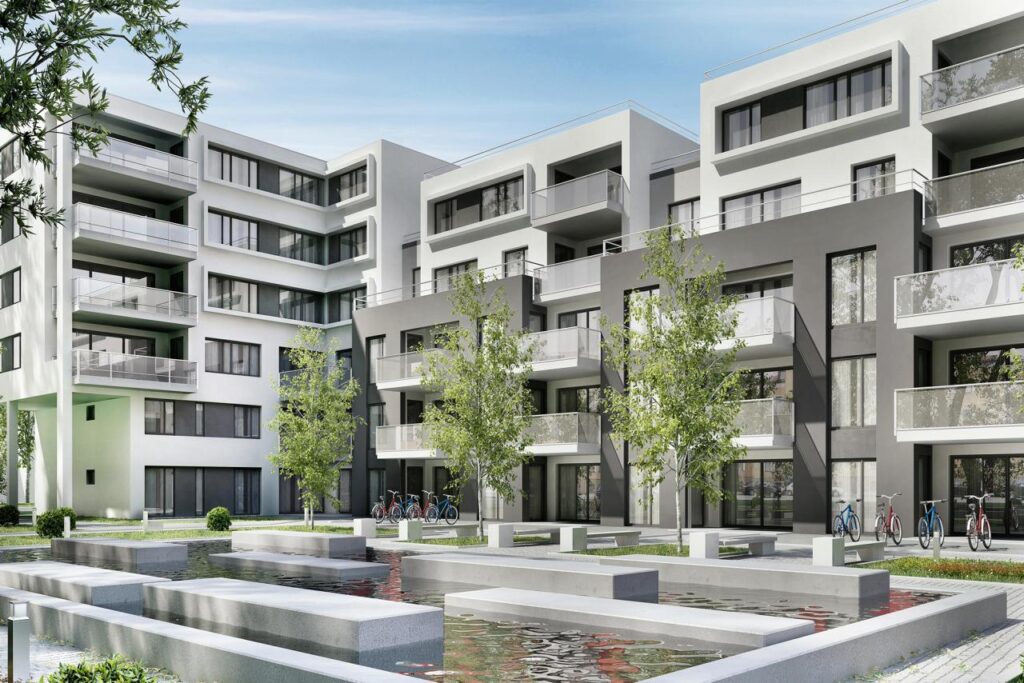The building and construction industry is a prominent consumer of natural resources, taking up to 50% of the resources. It also contributes heavily to environmental pollution, accounting for 39% of CO2 emissions, 50% of landfill wastes, and 40% of water pollution.
Recently, sustainable construction has been gaining attention. Both environmentalists and governments have been pushing the industry to be more environmentally friendly. This has seen the introduction of incentives and penalties to drive change in the industry.
In the wake of this wave, the industry has been slowly changing, embracing green building techniques and trends to ensure sustainable construction. Trendsetters have even moved into an ‘Ecology First’ paradigm of sustainability to minimise the use of natural resources.
In this post, we’ll explore the green building techniques and methods firms can adopt for environmentally friendly projects.
Free eBook: Quick guide to Lean practices for construction professionals
Smaller is better
According to Shrink Foot Print, the average house size in the UK is relatively small at 76 m2 (818 ft2). While this is better compared to the top country, Australia, which leads at 214 m2 (2302 sq. ft), it’s still vital to push for smaller homes.
Generally, small houses are below 1000 sq. ft, and they present several benefits. Given their sizes, they consume fewer materials and less energy; thus, they’re cheaper to build. Also, they offer great options for solar photo-voltaic systems — you can power everything using solar.
Comparatively, larger houses have more heating and cooling needs, leading to more carbon emissions from residential energy. A smaller house reduces waste, promotes efficiency, and decreases costs, making it an environmentally friendly option.
Building smaller is even better if you’re using materials like steel and aluminium, which consume a lot of energy to produce. Bear in mind that energy and resources used to extract, manufacture, process, and transport the materials are impactful, too.
Energy-efficient equipment
Old and inefficient equipment in construction sites usually pollute the environment. This can be through excessive oil leaks, noise pollution, and CO2 emissions. In some construction sites, energy consumption accounts for up to 6% of the budget.
Instead, you need to replace such equipment with energy-efficient options. You’ll need to conduct an energy audit to identify equipment and machines that consume more energy and pollute the environment.
For example, manufacturers like Volvo and JCB have been improving their product lines to offer low-emission units. A good example is the JCB 525-60E, an electric Loadall telescopic handler with a lift capacity of 2.5 tonnes and ample performance that equals some diesel units.
Also, use automation and smart devices to monitor your equipment and optimise energy use during construction. Technology like sensors, temperature regulators, and cameras can help you identify areas of improvement and improve equipment management.
More to read: Why are green buildings important?
Proper insulation
Proper insulation is one of the effective ways to reduce energy consumption and carbon emissions. Ideally, insulation minimises heat loss, particularly during colder months of the year. This means a homeowner won’t need to use their heating units running regularly.
There are different areas contractors can insulate, including cavity walls, solid walls, floor, root and loft, windows and doors, tanks and radiators, and draughts. For instance, homeowners can save up to £490 on heating bills a year with wall insulation, according to the Energy Saving Trust.
As such, contractors should incorporate insulation in their projects to reduce energy costs, prevent moisture condensation, and minimise the emission of pollutants. It can also help with fire protection and safety and maximises the returns on investment (ROI).
It’s even better to use insulation materials that contain recycled content. For example, fibreglass insulation has 40-60% recycled material, while cellulose insulation can contain up to 80% recycled content or even more.
Reuse, reduce, recycle
Waste is a significant problem in construction sites, and most of it ends up in landfills. Some contractors even leave the trash behind after completing the project. This increases the environmental impact of construction, considering the industry generates 62% of the UK’s waste and 32% goes to landfills.
Contractors need to reuse, reduce, and recycle materials. This not only reduces the environmental impact of construction but also saves you money. You can reduce material usage by minimising damage, reworks, and replacements and also streamlining your supply chain to avoid over-ordering.
Improve project coordination to ensure surplus materials are used in other phases, or you can sell or donate them. For example, pallets can be returned to suppliers or repaired for reuse. Materials like paper, timber, tyres, copper, concrete, and space metal are recyclable to reduce waste.
Also, you can use salvage materials as part of your green principles. Using salvage materials helps to keep waste out of landfills. Good examples include old slate shingles, bricks, steel, lumber, etc. Find deconstructed buildings in your area to find materials you can salvage.

Sustainable materials
Apart from reusing, reducing, and recycling materials, it’s also crucial to use sustainable materials to protect the environment. Note that the construction industry consumes 40 to 50% of natural resources in the global economy.
The industry can do better by promoting sustainable use of resources, and many experts are already taking the right steps in this direction. They’re using sustainable materials like bendable concrete, bamboo, cork, mass timber, precast concrete, and mycelium in projects.
Sustainable construction helps to conserve the environment, protect nature, and reduce toxic emissions. With sustainable materials like stone, precast concrete, and bamboo, you can still get aesthetically appealing projects while ensuring a safer environment.
Aim to use materials that are recyclable, compostable, and contain no harmful substances. For example, use wood treatments and paints that are natural with no solvents or chemicals that impact the environment. Material like cellulose is ideal for insulation as it is compostable.
You might also like: Sustainable construction: What you need to know
Solar panels
Going solar during construction has different benefits, including increased property values, reduced carbon footprint, and decreased energy expenses. For example, the average home with a 4kW solar system can save up to £270 on electricity bills per year.
By law, new builds have a requirement to have energy-saving measures, and installing solar panels allows contracts to adhere to the Standard Assessment Procedure (SAP) regulations. Apart from offering a source of renewable energy, solar doesn’t affect a building’s design.
According to research by the UN, solar panels produce 25g and 32g of CO2 per kWh of electricity, compared to 400g/kWh by fossil fuels. Additionally, homeowners and businesses with large solar systems can sell surplus energy to the grid through a Smart Export Guarantee (SEG) tariff.
During construction, you can also use solar panels to generate sufficient power for lighting, security systems, power tools, heating systems, ventilation, etc. You don’t need to rely on noisy diesel engines and generators to power your construction site.
Energy Star windows
Installing Energy Star windows can reduce energy consumption and lower carbon footprint. Note that the average UK home loses 25% to 35% of its heat through windows. So, installing windows with a high energy-efficiency rating is advisable, with the best rating being A+.
In this case, builders have different options, including low-emissivity windows and double/triple-glazed windows. Low-emissivity windows tend to be up to 40% more efficient than standard double-glazed windows.
Energy-efficient windows also come with different frames, including uPVC, timber, and aluminium. Windows with uPVC casement score the highest in energy efficiency, and they can reduce draught, too.
Generally, Energy Star windows can cut energy bills by up to £120 a year. Also, replacing single-grazed windows or double/triple-glazed options adds a layer of insulation, reduces dampness, limits outdoor noise, and increases security.
Rainwater harvesting
Water harvesting is a sustainable way of protecting natural resources, saving energy, and preventing the effects of stormwater run-off. This element should be incorporated early in the design phase to make the building environmentally friendly.
For example, project managers can consider installing portable water harvesting units to provide water for activities, like staff welfare facilities, cleaning, dust suppression, etc. This ensures self-sufficiency and prevents interruptions during water shortages.
Harvesting rainwater reduces reliance on mains water supplies, which are forecasted to run out if demand remains steady. It also helps to reduce emissions since water companies in the UK account for up to 6% of the total carbon emissions.
It’s therefore important for developers to install commercial greywater and rainwater harvesting systems to ensure sustainability and protect natural resources. These systems can be helpful during and after construction, so it’s important to install them early.
Eco-friendly lightbulbs
Most incandescent bulbs consume up to 100 watts of power, and this can cost users about £0.012 per hour. LED light bulbs are better options since they use about 10 watts, costing about £0.002 per hour.
Some light bulbs are even harmful to the environment, particularly those that contain mercury. This can be hazardous when disposed of improperly. Light bulbs with a shorter lifespan usually increase the amount of glass in landfills. Excessive artificial light also disrupts ecosystems and washes out starlight during the night.
Therefore, it’s vital to install eco-friendly light bulbs like LEDs, which can last up to 50,000 hours and use less energy. They’re also made of recycled materials like plastic. Experts recommend warm-coloured LED and CFL light bulbs since they’re more energy efficient than incandescent and halogen bulbs.
Additionally, it’s wise to install monition sensors or timers for outdoor lights to minimise energy consumption.
Further reading: 7 ideas to make implementing lean more successful for your construction projects
Power green building with technology
The construction industry is the biggest consumer of natural resources. It also produces the most waste, such as dust, asbestos materials, adhesives, tar, plastic, etc. Therefore, the industry should be at the forefront of pursuing sustainable practices, processes, and materials.
All stakeholders, including builders, owners, architects, engineers, designers, and contractors, should champion environmentally friendly construction through green building techniques. Ideally, any initiative that minimises material consumption, reduces energy use and lowers CO2 emissions should be embraced.
At LetsBuild, we believe green construction adds value at every scale, reduces the overall project’s cost, and protects the environment. We provide digital solutions to monitor and track every aspect of construction to support sustainable building.
Book a demo to learn how our purpose-built solutions will help you build environmentally friendly projects faster and smarter.




